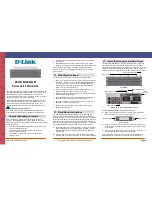
User’s Manual
342
3~12 watts
PoE Splitter
PoE Splitter split the PoE 56V DC over the Ethernet cable into 5/12V DC
power output. It frees the device deployment from restrictions due to power
outlet locations, which eliminate the costs for additional AC wiring and
reduces the installation time.
3~25 watts
High Power PoE Splitter
High PoE Splitter split the PoE 56V DC over the Ethernet cable into 24/12V
DC power output. It frees the device deployment from restrictions due to
power outlet locations, which eliminate the costs for additional AC wiring
and reduces the installation time.
30 watts
High Power Speed Dome
Its state-of-the-art design fits in various network environments like traffic
centers, shopping malls, railway stations, warehouses, airports and
production facilities for the most demanding outdoor surveillance
applications. No electricians are needed to install AC sockets.
4.16.2 System Configuration
In a power over Ethernet system, operating power is applied from a power source (PSU or -power supply unit) over the LAN
infrastructure to
powered devices (PDs)
, which are connected to ports. Under some conditions, the total output power required
by PDs can exceed the maximum available power provided by the PSU. The system may come with a PSU capable of
supplying less power than the total potential power consumption of all the PoE ports in the system. In order to maintain the
activity of the majority of ports, power management is implemented.
The PSU input power consumption is monitored by measuring voltage and current .The input power consumption is equal to the
system’s aggregated power consumption .The power management concept allows all ports to be active and activates additional
ports, as long as the aggregated power of the system is lower than the power level at which additional PDs cannot be
connected .When this value is exceeded, ports will be deactivated, according to user-defined priorities. The power budget is
managed according to the following user-definable parameters: maximum available power, ports priority, maximum allowable
power per port.
Reserved Power determined by
There are five modes for configuring how the ports/PDs may reserve power and when to shut down ports.
Classification mode
In this mode each port automatically determines how much power to reserve according to the class the connected PD
belongs to, and reserves the power accordingly. Four different port classes exist and one for 4, 7, 15.4 and 30.8 watts.
Содержание IGS-10020
Страница 1: ...User s Manual...
Страница 31: ...User s Manual 31 IGS 10020PT IGS 10020PT Dimensions W x D x H 72 x 107 x 152mm...
Страница 32: ...User s Manual 32 IGS 10020HPT IGS 10020HPT Dimensions W x D x H 72 x 107 x 152mm...
Страница 33: ...User s Manual 33 IGS 10080MFT IGS 10080MFT Dimensions W x D x H 72 x 107x 152mm...
Страница 34: ...User s Manual 34 IGS 12040MT IGS 12040MT Dimensions W x D x H 72 x 107 x 152mm...
Страница 35: ...User s Manual 35 IGS 20040MT IGS 20040MT Dimensions W x D x H 72 x 107 x 152mm...
Страница 36: ...User s Manual 36 IGS 20160HPT IGS 20160HPT Dimensions W x D x H 84 x 107 x 152mm...
Страница 46: ...User s Manual 46 Figure 2 16 IGS 10080MFT Upper Panel Figure 2 17 IGS 12040MT Upper Panel...
Страница 47: ...User s Manual 47 Figure 2 18 IGS 20040MT Upper Panel Figure 2 19 IGS 20160HPT Upper Panel...
Страница 181: ...User s Manual 181 Figure 4 8 2 Multicast Flooding Figure 4 8 3 IGMP Snooping Multicast Stream Control...
















































